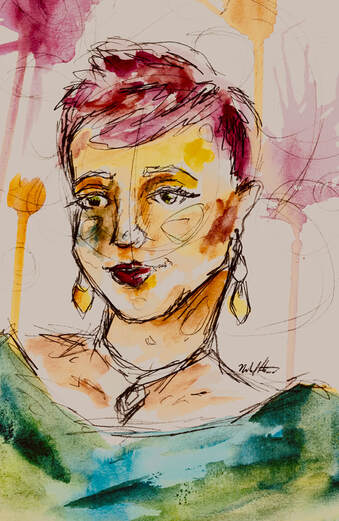Creating characters your fiction readers will wish to support and cheer on for 300+ pages is crucial. Let's discuss.
TIPS for writing realistic, colorful characters:
1. Unless your character is named Bo Derek, she's not a perfect "10" (I'm dating myself, I know). We might want gorgeous hair, a stellar bod, a genius IQ, tons of $$$, and a winning personality, but perfect people don't exist in real life. Even a real person, who may seem perfect at first glance, will have a fault or insecurity lurking just below the flawless surface. Faults and insecurities are what make a character real and relatable. Identify such. Expose such. Use such.
2. A protagonist needs redeeming qualities. You've heard the phrase "gruff but lovable?" Make sure your protagonist isn't so fraught with faults and insecurities that he or she is unlikeable. A character must change from the beginning to the end of a story (character arc is a thing), but you don't want a character to be such a mess readers don't want to take that journey. If the protagonist has a foul mouth and prickly demeanor, create a balance. Have him or her do something to let the true character shine through. Adopt a side-kick from the local animal shelter? Maybe. Slip a $20 tip on the counter for the single mother bartender? Sure. You get the idea.
3. Antagonists can have shades of good. Taking tips #1 & #2 one step further, realize that no character should be black or white, bad or good. Quoting one of my favorite musicals, "Ogres are like onions." Everyone has layers (even Shrek, who was definitely not the antagonist, despite many of the storybook characters originally thinking he was a big, bad, scary green dude). Unless a character is pure evil, he or she can have some good. That's what makes him human, interesting, relatable, and unpredictable.
4. Speaking of unpredictable, avoid stereotypes. Dumb jock. Brainy introvert. Vain beauty queen. Assumptions are made about certain people groups, even though there are just as many vain jocks, dumb introverts, and brainy beauty queens (see what I did there?). The point is to avoid stereotypes. Take your first idea of a character and spin the dial to something a few degrees left or right of what a reader expects. Change it up, and your character becomes much, much more interesting.
5. Actions speak louder than words. It's a trite phrase, but it's true. It is with the actions or reactions of characters that readers really get to know them. If your protagonist insists she hates music when asked to join the choir, but she sings solo in the shower every morning, we gain a clue to her true personality and some of those pesky insecurities. When writing fiction, be sure to use your character's actions to your advantage and as a way to add layers to the character and story.
6. Do your research. If you're writing for or about teens, you better have access to teens. Go to the mall. Watch your own children interact with their friends. Ask a teen to beta read your work. The same can be said of any specialized group of people you may be writing for or about, whether a beautician, widower, teacher, CEO, farmer, alcoholic, etc. Do whatever you can to familiarize yourself with and understand that character in a real-world setting, because you can't write what you don't know.
7. Know a character's language. Wooden or unnatural dialogue can quickly create a disconnect. Each character should have very distinctive patterns of speech, so it is obvious, even without a tag, that the dialogue came from a particular character. Example: in my working manuscript, I have a retired baseball player who calls his daughter "kid" and uses coaching lingo. I don't use this tactic in every bit of dialogue, but I've sprinkled it in enough that it's become synonymous with that character.
8. Don't allow a secondary character to steal the show. Everyone loves a larger-than-life character, but be careful a secondary character doesn't become a distraction and/or unbelievable caricature. Like in theater, the character who stumbles onstage in a crazy outfit, throws out a one-liner with exaggerated facial expressions and body movements, and just as quickly stumbles back off the stage can be great for a brief laugh and moment in the spotlight. However, if that same character is hamming it up in a group scene while the main character is doing a major life monologue, it can detract from readers getting to know something about the protagonist.
Anyway you write it, a character who is realistic and colorful can build a connection with his or her readers. YOUR readers.
Good luck and write on!
As always, thanks for the artwork, Michelle Haas.
#CharacterDevelopment #WIP #Writer #MondayMotivation #WednesdayWisdom #WritingCommunity #AmWriting #AmEditing

 RSS Feed
RSS Feed

